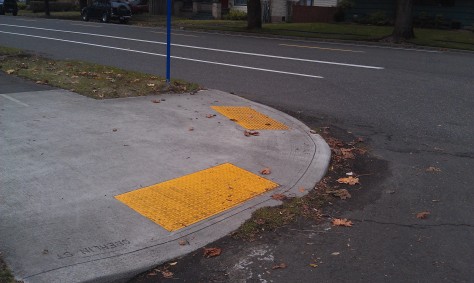
The sun was out the other day – a rare treat in January, as you may know – so we decided to take a family walk around our North Portland neighborhood. Many of the sidewalks in Portland are decades old and pre-date modern standards, lacking curb ramps and other features that are now required on new construction.
Always wanting more speed, the kids opted for scooters over walking. After all, who wants to run when with half the effort you can get twice the speed and recklessness? At the first intersection, our 5 year old son bottomed out trying to jump the curb and nearly landed on his face in the middle of the street. We had the following conversation.
Me: Careful there, you almost lost it.
5 year old: What, dad?! That’s just the way I do it!
This was a good reminder that our streets are used by all kinds of people, for all kinds of purposes and – 5 years old or otherwise – everyone has their own idea about what they are doing. The ADA Standards for Accessible Design set a basis for designing and constructing projects that accommodate all of these people, purposes and ideas. Curb ramps are one of the more visible elements of these standards.
Aside from the ramp’s geometry, the most significant consideration in designing a curb ramp is how to best incorporate the required “tactile warning strip”, the part of the ramp that addresses ADA surface texture and color contrast guidelines. These guidelines were established to ensure that people with impaired vision know that they are leaving the sidewalk and entering the street.
This post will give you a general overview of design considerations for tactile warning strips, including: color selection, installation methods, material types and available products. Throughout the post, you will find links to related sites, should you want additional information.
Color Selection

A surprising amount of research and debate has gone into color selection for tactile warning strips, but it is safe to say that yellow is the standard or default color. An in depth study by the Federal Highway Administration looked at ten different colors and three black/white zebra patterns and generally supports this.
The problem, though, is that designers, owners and developers spend a lot of time and money carefully selecting materials and colors for their projects and aren’t always enthusiastic about scattering yellow stripes across their site. So, the debate will continue and really no particular answer is always right.
As FHWA’s research shows, contrast with the surrounding walkway is the most important color consideration.
Installation Method: Cast in Place vs. Surface Mounted

The method of installation for tactile warning strips varies significantly from product to product. Some tiles are designed to be set in wet concrete while others are applied to dry concrete like giant stickers. Others still are bolted down with anchors that are either set or drilled into the underlying ramp. Properly selecting a system can be the difference between an installation that stands up over time and one that needs to be replaced a short time later.
In general, tactile warning strips installed on new curb ramps should use products that are designed to be cast in place. The resulting installation will be less likely to be damaged by movement and incidental wheel loading. Surface mounted products are better saved for retrofit applications, where a warning strip is needed on an existing curb ramp.
Material Types
As with drainage pipe, different tactile warning products are often made of different materials. Plastic systems make for easy installation and are engineered to stand up against pedestrian and vehicular traffic. Concrete panels and pavers can offer a more architectural look, but this can come with higher installation costs, less durability and more long term maintenance. Thermoplastic panels are very inexpensive and easy to install, but may not be the right choice for maintenance reasons.
Durable, well designed products that are easy to install can be more expensive then their competitors. It is the project designer’s job to evaluate the specific project requirements and determine if using a slightly more expensive product would benefit the project in the long run. In the area of tactile warning strips, materials usually have a far smaller impact on life cycle project costs than does the maintenance that comes along with them. Selecting the right long term solution is the key to a successful project in this respect.
Available Products
Several manufactured products exist. Most are available in a wide range of colors and all have nearly identical texture patterns. Where these products differ is in installation method and materials. Properly evaluating these differences during design often determines the long term performance of the ramp.
This is not meant to be a comprehensive list, but only a selection based on my research during design.
Armor Tile

My favorite tactile warning products are made by Armor Tile. Armor Tile products are made of a polymer composite that resists wear and UV degradation. The flexibility of the composite combined with the structure of the tiles creates a surface that can support heavy loads without being prone to catastrophic cracking. Armor Tile products have an aggressive surface texture to prevent slips.

The perforated, ribbed back of Armor Tile’s Cast in Place System works well for both locking the panel in place and supporting occasional wheel loads. Their Surface Applied System is installed using screws and concrete anchors and is a solid choice for retrofit installations.
Cast in Tact
Made from a fiber reinforced, cementitious material, Cast in Tact products are a good solution for projects that require a more architectural look than can be achieved with Armor Tile’s composite panels. These panels have a fairly good reputation for quality and durability, but there are a few recurring issues that should be considered.
Essentially large concrete pavers, Cast in Tact panels are less forgiving than Armor Tile’s during construction. It is not uncommon to see installations with chipped edges or cracks through the panels. Technically, the owner should have the right to require the contractor to replace broken panels. However, this usually requires replacing part or all of the ramp – a major repair for what amounts to a relatively minor problem – and isn’t always realistic.
Looking at different installations, you might also notice that the domes on concrete panels tend to wear down over time. Though the Cast in Tact panels are durable, they are not immune to this problem. The supplier has attempted to address this problem by designing a method for replacing individual domes. I don’t know of any installations where this has been used, but it seems like a fairly time consuming – therefore expensive – repair.
Arcis Corp.

One tactile warning product that is interesting, but that I have never used is that made by Arcis Corp. The Arcis panel looks very similar to the Cast in Tact product – a cement based panel that sets much like a paver – but also has bolt studs that extend into the underlying concrete to anchor the panel in place. As engineers we like a factor of safety, and Arcis’ product seems give us that.
Thermoplastic Tactile Strips

Several makers of thermoplastic pavement marking materials also offer tactile warning strips. Much like thermoplastic legend striping, these strips are laid on the concrete or asphalt ramp and torched. The resulting installation provides good visibility and can easily be fit to the specific installation.
The problem with thermoplastic tactile strips is that they perform very poorly over time. Wheel drag and weather loosen the tiles’ bond to the underlying surface and the tiles eventually begin moving. These tiles are pretty common, which means the problems that come with them are, too. You will probably be able to spot damaged or missing thermoplastic tiles without too much looking.
Because of the maintenance problem posed by thermoplastic tactile warning strips, I suggest you avoid them for anything other than temporary installations.
Suggested Design Considerations
In designing curb ramps, you may find it helpful to weigh the pros and cons of different options using the following questions.
- What color is the surrounding walkway? What colors of tactile warning strip would provide an acceptable level of contrast?
- What kind of traffic will come in contact with the curb ramp? Is there a chance that truck wheels could drag across the ramp while turning?
- Would a cast in place product or a surface mounted product be best for the installation?
- How will the chosen product perform long term?
There are a lot of tactile warning systems on the market, and the temptation can be to leave the decision to the contractor. Some flexibility in material selection is a good idea and can benefit the project, but that is only true to a point. Too little direction can lead to a project that costs about the same amount of money, but doesn’t perform as well as expected over the long term.
